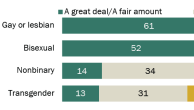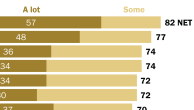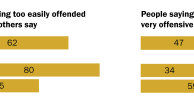Download the summary of results with questions: Summary of Results with questions PDF (1.03 MB 21 Pages)
Government Restrictions on Religion
To assess the level of restrictions on religion by governments around the world, the Pew Research Center’s Forum on Religion & Public Life selected the following 20 questions for the Government Restrictions Index (GRI). The Pew Forum’s staff then combed through 18 published sources of information, including reports by the U.S. State Department, the United Nations and various nongovernmental organizations, to answer the questions on a country-by-country basis. (For more details, see the Methodology.)
This summary shows the questions, followed by various possible answers and the number and percentage of countries that fell into each category. For example, on Question No. 5 – “Is public preaching by religious groups limited by any level of government?” – the study found that for the period ending in mid-2009, 135 countries (68%) had no reported limits on preaching, 39 countries (20%) had limits on preaching by some religious groups and 24 countries (12%) had limits on preaching by all religious groups.
To see how each country scored on each question, see the Results by Country.
This summary covers two overlapping periods: July 1, 2006, through June 30, 2008, and July 1, 2007, through June 30, 2009. The summary shows whether particular religious restrictions occurred at any time during the periods according to the multiple sources analyzed by the Pew Forum.
Some differences from year to year might not be as significant as they appear due to minor changes in coding procedures and changes in the amount of information available between years. For example, sources for the most recent period studied sometimes had more information on incidents in a country than sources previously had reported. Such additional information may reflect either an actual increase in restrictions in a country, improved reporting for that country or both. For additional information, see the notes on individual questions and the Methodology.
Percentages may not add to 100 due to rounding.
Summary of Results with questions PDF (1.03 MB 21 Pages)
Social Hostilities Involving Religion
To assess the level of social hostilities involving religion around the world, the Pew Research Center’s Forum on Religion & Public Life used the following 13 questions for the Social Hostilities Index (SHI). The Pew Forum’s staff then combed through 18 published sources of information, including reports by the U.S. State Department, the United Nations and various nongovernmental organizations, to answer the questions on a country-by-country basis. (For more details, see the Methodology.)
This summary shows the questions, followed by various possible answers and the number and percentage of countries that fell into each category. For example, on Question No. 12 – “Were there incidents of hostility over proselytizing?” – the study found that for the period ending in mid-2009, 127 countries (64%) had no reported incidents of hostility over proselytizing, 39 countries (20%) had incidents that fell short of physical violence and 32 countries (16%) had incidents involving violence.
To see how each country scored on each question, see the Results by Country.
In general, this summary covers two overlapping periods: July 1, 2006, through June 30, 2008, and July 1, 2007, through June 30, 2009. The summary shows whether particular religious hostilities occurred at any time during the periods according to the multiple sources analyzed by the Pew Forum. In some questions (SHI Q.6-13), events going back to the previous year (mid-2005 for the period from mid-2006 to mid-2008, or mid-2006 for the period from mid-2007 to mid-2009) are also included in the findings if they were having an ongoing impact.
Some differences from year to year might not be as significant as they appear due to minor changes in coding procedures and changes in the amount of information available between years. For example, sources for the most recent period studied sometimes had more information on incidents in a country than sources previously had reported. Such additional information may reflect either an actual increase in restrictions in a country, improved reporting for that country or both. For additional information, see the notes on individual questions and the Methodology.
Percentages may not add to 100 due to rounding.




